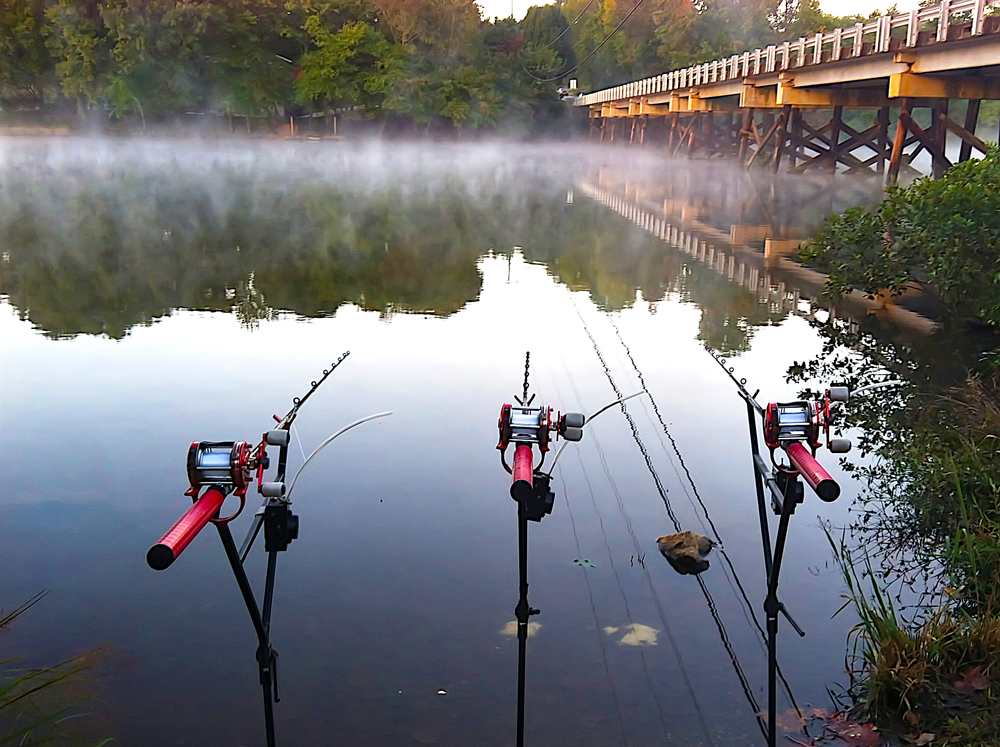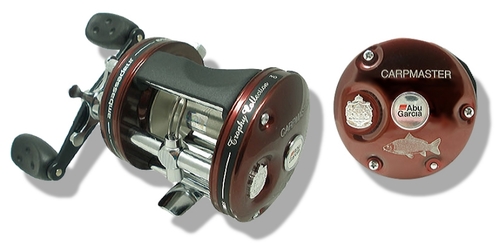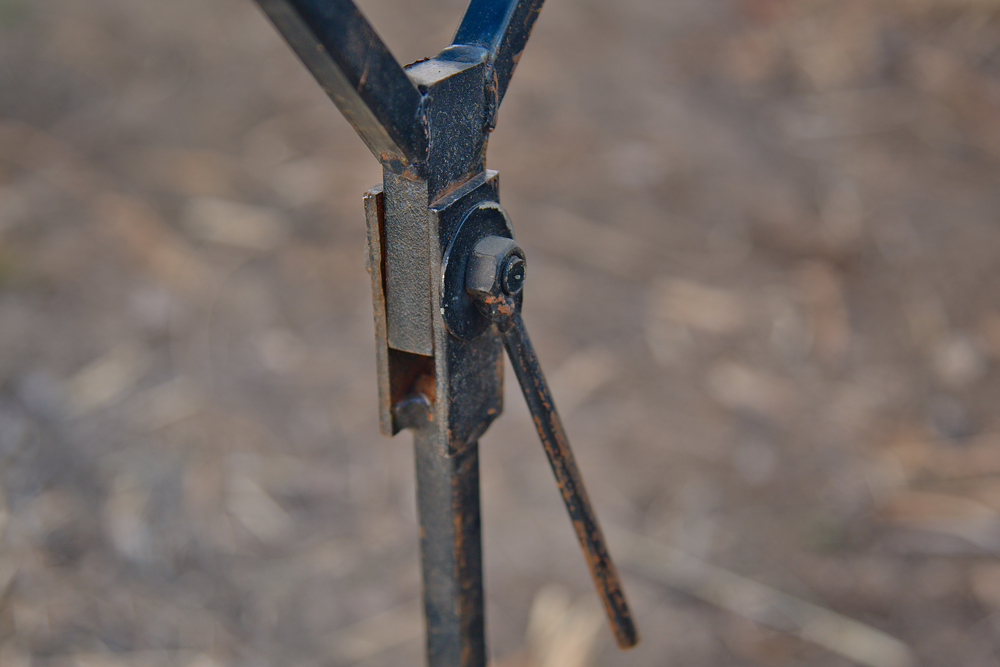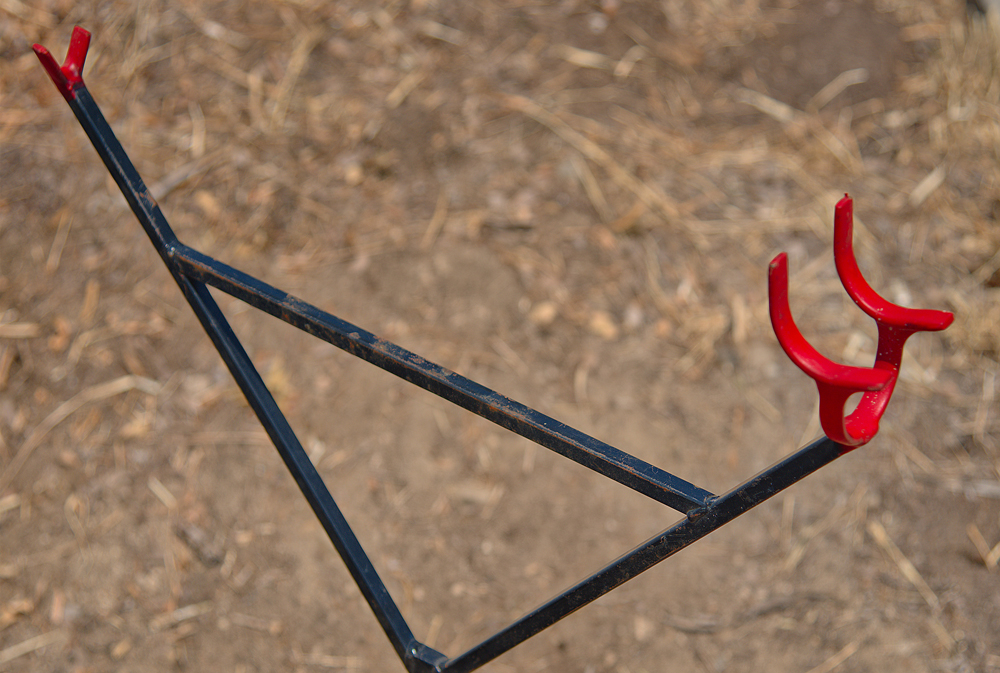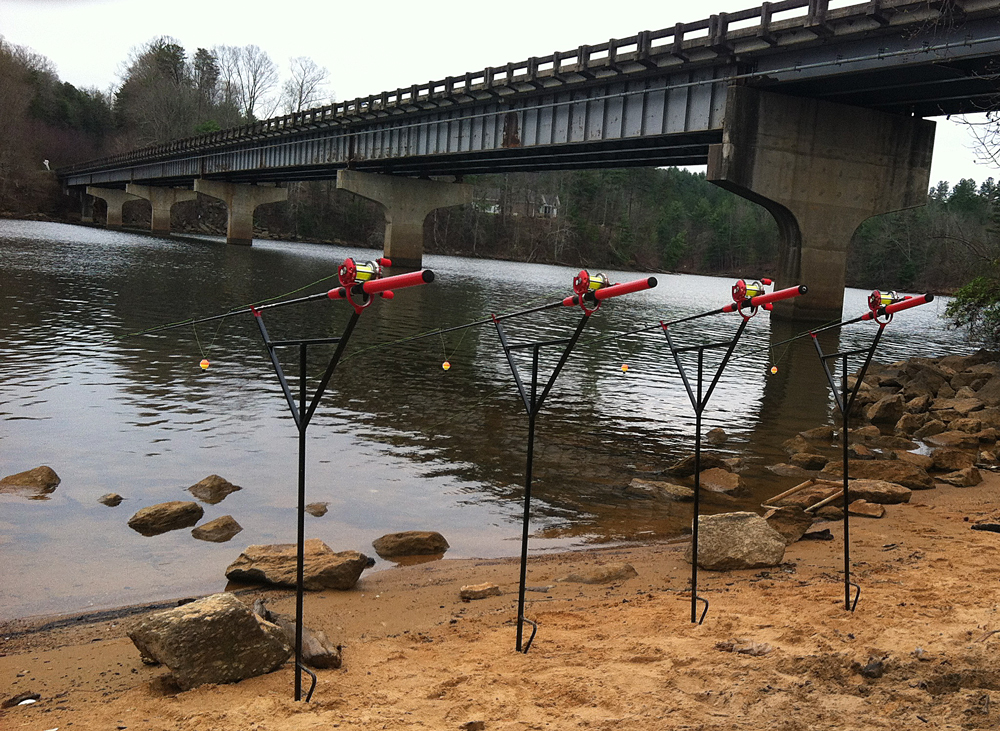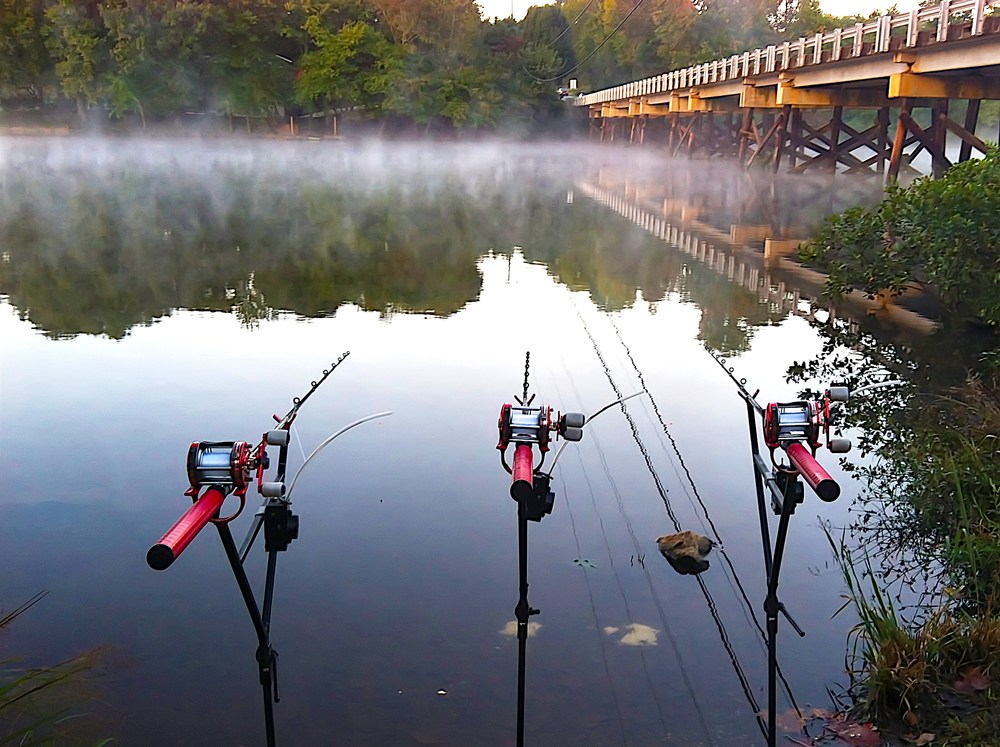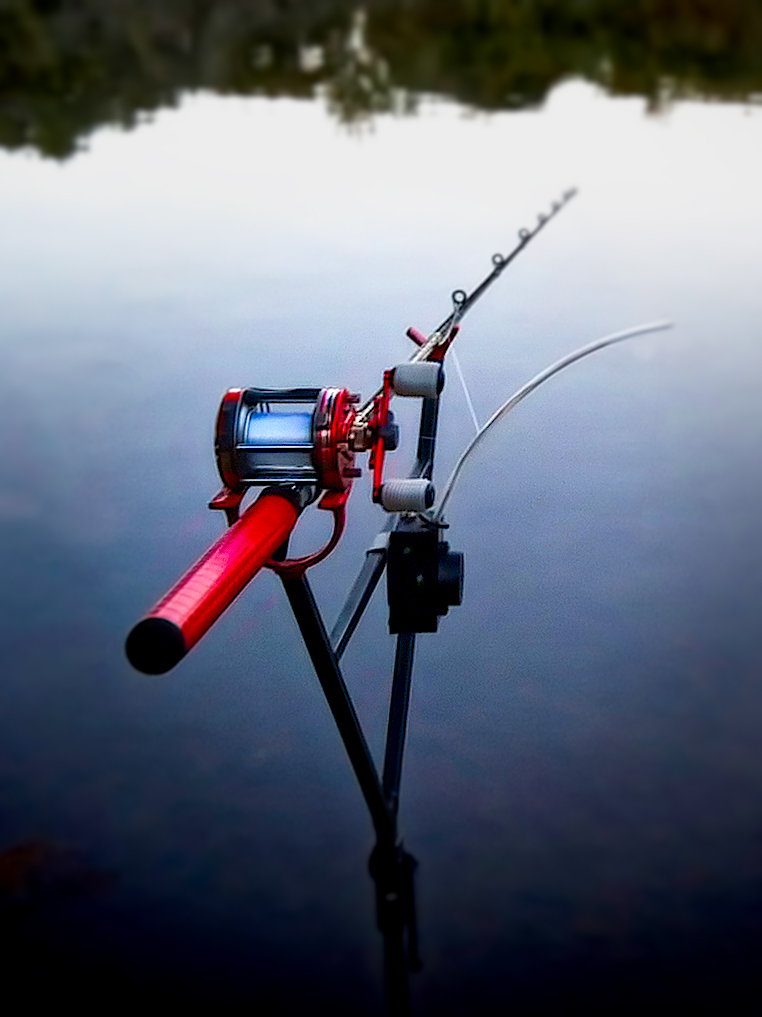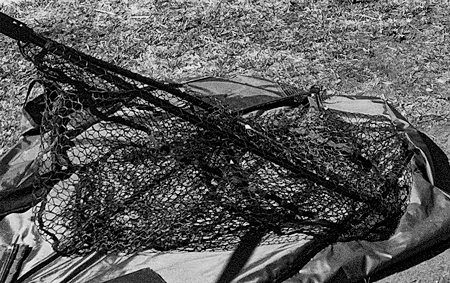BY JAKE HARRIS
Jake was born and raised in North Carolina. He is an extremely able and experienced Pay-Lake specialist who is equally at home on any 'wild water' here in the United States. A true American traditionalist angler who really 'lives and breathes' his sport putting much effort into respecting and caring for his quarry.
PAYLAKE STYLE
Paylake fishing is a unique form of fishing that originated in the state of North Carolina. The term “paylake” is exactly as it sounds, a paylake is a lake in which a person pays a fee in order to fish. Generally these lakes are small and privately owned; the owner stocks the lake with wild carp caught by nets from a private fish hauler, most of the loads range from 2,000 - 20,000 lbs. The importance of stocking is crucial in order to keep the customers happy and catching carp. A good lake owner will stock regularly so the word spreads that he has a good fishery.
HISTORY
1800-1900’S
Although it's unclear, paylakes started as a place for farmers to make an extra buck by allowing others to fish in their ponds for a small fee. Most of the “Paylakes” in this era had a variety of species in them including catfish and various species of panfish (Bluegill, Crappies etc.) Some lakes charged an additional fee to process or fillet the fish for the customers.
1950-PRESENT
In the 1950’s paylakes began to modernize and became focused on the competitive aspect of it all more so than the livelihood of the owner and paying customer. Paylake fishing became a friendly competition with a small wager involved. The older paylakes were very simplistic compared to the modern paylakes of today. There are now more than 75 paylakes in North Carolina alone. South Carolina, Indiana, Pennsylvania and Georgia all have a good handful of paylakes each as well.
The early paylakers fished with very simplistic equipment. Most used old Johnson century model 100 reels and a short fibre-glass rods (cut short to make the rod stiffer). Worms, whole kernel corn and bread balls were the bait of choice in those days. The invention and introduction of the Zebco 33 in 1954 was the dawn of a new age for many of these paylakers because of the reel's low cost, durability, and it's ability to cast with ease. It also had an incredible retrieval speed for the era.
+ READ MORE
OPERATION
To begin with, each paylake operates in somewhat of a different manner. It can be a very confusing event for someone who may have never fished at a paylake before. It is also confusing for most natives because each privately owned lake makes up its own rules and programs. Lakes in the western part of North Carolina tend to be run differently than the lakes to their east.
To break this down, we will explain how the two areas are somewhat different from one another. Paylakes tend to vary in size and number of fisherman. Lakes range from the size of a tennis court to the size of a football field. The Western lakes are usually shoulder to shoulder while their Eastern brothers are generally larger, providing each fishermen with a larger “peg.” Each peg is marked off by a number, these numbers are very important not only because it shows the fishermen his casting boundaries, but because it's also used as a way to designate the area where the fisherman will be setting up and fishing according to the number he has pulled from the draw, or “drawed out." The term “drawed out” is basically a game of pure chance.
Before a tournament begins all of the fishermen gather around and draw poker chips with a number on it from a bucket. Once everybody has received a poker chip with a number on it, poker chips are randomly drawn from another bucket and announced by the owner or lake manager. If your number happens to be the first one drawn out of the bucket you get the opportunity to pick any spot on the lake to fish at, if you're the second person to be drawn out you get to be the second person to choose the spot on the lake you want to fish. The drawing of numbers continues until the last person gets 'drawn' out. Ideally you want to be the first to be drawn out so you can fish the spot you want based on your experience, word of mouth or other information that you may have.
Map of a typical Paylake, showing spots/pegs/swims with center dividing rope
Paylaking is a game of chance in a sense. Once everyone has been drawn out and pegged the paylakers are given a few minutes to get their gear and baits organized and set up, no fishing is allowed at this time. After a short period of time a buzzer will sound off over a loud speaker informing the fishermen that the tournament has now began and everyone can start casting out. Once fishermen have cast out their rods, IT’S ON! The fishermen not only compete to catch fish but also compete with each other by playing either offense or defense. A paylake fisherman must use baiting strategies, bait, and knowledge to outwit his neighbors in order to be successful. To be successful you must also react to how the fish are biting. Paylakers concentrate and zone in on their fishing at these lakes because their hard earned money is on the line. We will explain how paylakes payout and run as a business.
+ Winning Paylakes and Payouts
PAYLAKE TACKLE
Now that you know some information on how paylakes are managed and operate, we will get down to the what, why, and how the fishermen of these small lakes tackle the carp within a time pressured environment.
RODS
Paylake fishermen usually prefer a rod that varies in the lengths of 7ft - 11ft. The rods should be 'medium heavy' or 'heavy' in action. The reason the paylakers prefer the stiffer action rods is due to the 'shoulder to shoulder' environment in which they fish. A stiff rod is needed in order to keep hooked fish from swimming sideways into your neighbor's lines; if the fish does however swim into your neighbor's lines... he may not be so 'neighborly'. The other importance of having a stiff action rod is to literally 'winch' fish in as in the paylake world... time is money.
Below we will list just a few of the popular rods that paylakers use. Most of these rods are telescopic meaning they contract or collapse down to about a foot long for easy storage purposes:
- BPS Graphite series
- BPS Bionic blades
- BPS Extremes
- Browning Medallion
- Berkley Lightning rods
- Abu Garcia veritas’
Most of the rods listed average $50 to $60 with the BPS extreme costing around $100Most of these rods are nothing more than heavy action bass rods.
Reels
Ask any paylake fisherman what brand of reel he prefers and it will be none other than the Abu Garcia. Abu started out as a small watchmaking company in Sweden in 1921. World War II caused a sharp decline in business and Abu began to focus on making precision fishing reels. In 1952 Abu introduced the world famous 'Ambassadeur' series. The 'Ambassadeur' still remains very popular in the paylake scene of today. The reels are known for their extreme reliability and precision in skilled hands. Besides being reliable Abu Garcia reels are often preferred for a couple of reasons. Most models come with a “line out alarm” or “clicker” as it’s commonly called. When the clicker is engaged the fish can run freely without any tension. Once the clicker begins to sing the angler can grab the rod and set the hook. Clickers are useful for night fishing, sleeping, or being at a distance from your rods.
Line
Paylake guys usually use a line with a 12-20lb breaking strain. Mono is preferred over braid due to the cheaper cost. The color of the line doesn't seem to have any effect on the bite to these hungry carp. Many of the local paylakers tend to like 'Hi-Viz' or 'High Visibility' line in either orange or yellow. 'Hi-Viz' line is easy to see and picks up on small bites that may otherwise be missed. Sufix, Stren and Berkley are favored brands.
Rigs
A paylake rig uses either a 'wide bend' hook or an 'octopus hook'. The leaders are most often tied on by a knotless knot and are 'double stranded' giving them a stiff-rig type action especially when tied with a thick diameter mono in 17 or 20lb test monofilament. There are some paylakers who tie leaders with braided line, however this can result in many more lost fish due to the 'no stretch' and supple presentation that braided line is known for. Additionally, braided line also lacks the stiff 'springy - type' action that monofilament exhibits. A true paylake rig needs to have a stiff material hook-link in order to assure the carp has minimal chance of blowing the hook bait out, which results in a fish that you don't catch and money that cannot be collected.
+ HOW TO TIE A PAYLAKE RIG
A paylake rig requires a three way swivel and two leaders 2-5 inches in length. The double hook rig has been used for years by paylakers.
If you don't feel that a 'two hook' rig is your thing then you can adjust it by replacing the three way swivel with a barrel swivel and add one leader instead two. The fish will benefit from a one hook rig simply because there's no extra hook thrashing around to harm the fish while playing it. Secondly your fingers and hands will thank you once you have the carp on the bank. The reason behind this is because it can 'get ugly' with an extra hook dangling around while you're trying to unhook a wild carp full of energy. If you do in fact plan to use two hooks use caution and hook the dangling hook into a hole in your netting while you free the other hook from the mouth of the fish.
Leads/Sinkers
The majority of Paylake fishermen use 'Egg' or 'No Roll' sinkers in ⅛ - 1 oz in weight. A 'no roll' lead sticks to the bottom and tends to stay right where it lands, unlike egg sinkers that can 'roll'. The flat lead flutters as it sinks which assists in the breaking of your pack-bait allowing the fish to get to your hook-bait quicker. When money is on the line any edge will help.
Rod stands
Rod stands are very simple, quick, and easy to use as opposed to a modern 'rod pod'. Paylake rod stands typically last for years. The very first rod stands were made out of old bicycle wheels that were cut in half to make a 'U' shape. The wheels, once cut in half, were notched out on each side so the rod had a place to rest. The 'half of a wheel' was then welded to a 1-2ft piece of steel which was used to stick into the ground holding the rod 'up' off of the ground. Stands have since evolved and now come in many shapes, sizes, colors and materials including stainless steel, which is a 'premium' set. Stands are available in fixed, or adjustable versions.
Adjustable stands allow you to fish with your rod tips pointed in the air or down towards the water, which can be useful in certain situations. Fixed stands that do not adjust are cheaper and less versatile. Modern stands have a foot peg at the bottom which comes in handy when the user needs to push the stand into the ground. The top of the stand has a cupped reel seat which keeps the rod from being jerked off of the stand during a violent take.
Click images below to enlarge
ALARMS / INDICATORS
Fishermen use various styles of alarms and bite indicators to know when the carp are 'around their hooks' and bait pile. Most alarms are electric and battery powered. Others are in the form of a bobbin/bobber that is used to 'catch the eye' rather than making a sound.
Bite Indicators
The most commonly used form of bite indication seems to be a small plastic bobber. Small plastic bobbers can be taken apart and 'gutted' of everything except the small spring inside. You can then insert a paper clip on the inside of the bobber and then use the bobber to clip onto your line 'in between ' your guides. The bobber will then dangle whilst the angler is waiting on a run from a fish. When a run occurs the bobber will raise up against the rod.
Many paylakers use the bobber technique whilst others will use a small piece of play dough or modeling clay as a bite indicator.
The play dough should be molded around the line in between the water and the rod tip, this enables the paylaker to see every single bump, peck, and blowout while the carp are feeding over the bait. It really gives an edge and allows the paylaker to pick up on things that might have otherwise been missed.
The European tackle company Solar tackle recently introduced a new item called the “line biter” which does the same exact thing play dough or modeling clay does.
Rods with bite indicators placed on the lines.
Various bite indicating bobbers and modeling clay.
Electronic Alarms
Alarms used by paylakers are relatively simple compared to the modern European type of alarm. Most of the American alarms are battery powered and are triggered by the tension of a running fish against the 'arm' of the alarm. Paylake alarms are hooked onto the middle bar of the rod stand. Once the rod is cast and the reel is in the stand the line is then placed on the 'opposite' side of the arm or 'straw' that extends out of the top of the alarm. Once a carp takes the bait and runs the pressure of the line against the straw moves it which in turn presses a trigger on the inside of the alarm sounding the alarm off. Alarms come in many different tones, volumes, and styles.
A short video showing three common Pay lake alarm units...
Landing Nets
Ed Cumings and Ranger nets are probably the most popular nets among paylakers in the South of the USA. They are very reliable nets and paylakers generally prefer them over the more expensive European models with finer mesh. Many of the paylake nets are actually made for very large salmon and catfish and so are very strong. The 8ft handle also helps when fishing tall banks that some paylakes have.
+ READ MORE ABOUT LANDING NETS
Carp Caddy/Carrying device
Carp Caddy (click image to enlarge)
A carp caddy or fish 'tote' as it's often called is a cylinder tube made to carry fish from an anglers peg to be weighed and then released. The totes are made of either plastic or aluminum. Carp caddy’s without proper padding however can be very detrimental to the health of a fish. The caddy is designed to carry a fish head first, meaning you place the carp head first into the tube. You should never attempt to place a carp in the caddy tail first. If a carp is placed into the caddy tail first it will result in a broken tail, broken spine or both. This isn’t something that will heal over time. In the heat of summer, a caddy should always be dunked in the water before carrying a fish, the water cools the caddy down so the fish does not burn.
Paylakers often use gas or electric powered scooters to go to and from the weigh station to save time and reduce unnecessary stress on the fish. The fishermen attach adapters that hold the carp caddy upright on the back of the scooters. Roads used to travel around the lakes can be rocky, uneven and bumpy. Many fishermen place a piece of thick foam in the bottom of the caddy to keep the fish from bruising its head while traveling. Weigh slings are a better alternative when used.
Baits and definitions of bait terms
The difference between 'packbait', 'method mix', and 'ground bait' has been argued and debated by many paylakers over the years; however if all three are studied, regarding their individual makeup, it is clear that they are not 'one and the same.'
There is however agreement on what exactly a traditional 'Packbait' is... and what it is not.
We will clarify the difference between the three terms and why 'packbait' is so efficient in a competitive setting at a paylake. This is the reason for its popularity.
It is important to note that 'method mix' and 'ground bait' are universally known angling terms whereas 'Packbait' is a traditional American term and is unique to the paylake history of the USA.
+ BAIT TERMS
Why PAYLAKERS believe packbait is superior to BOTH method and groundbait
Is there really that much of a difference between them? Yes...there is. Paylake anglers will not make make money or catch fish if their bait is not capable of performing in the correct manner, in the right amount of time. Method mix tends to break down slowly and contains multiple base mixtures, while packbait contains one base mix only. Method anglers often add a variety of different chopped boilies, pellets, nuts, and seeds to their mixtures. For lack of a better term a method mix contains “everything but the kitchen sink” assuming that more is better and more attractive. Paylakers use 1 base mixture ingredient instead of multiple to attract the carp instead of filling the carp’s belly with unnecessary added ingredients. Packbait is designed in such a manner that certain mixtures and certain ingredients appeal to the fish based upon the nutritional needs of the fish throughout the different seasons of the year. For example, a carp craves a fattening starchy meal in the cold winter while it desires a much less filling meal in the heat of the summer. If a carp wants one particular substance, why add other needless items it doesn't really want at the time? The hookbait needs to act as the “cherry on top” meaning the most attractive desirable item in the pile of broken down particles, which we will discuss later. Another great thing about fishing packbait with a traditional paylake rig is that you're able to legally use it in states that may consider fishing a with a ball of bait “chumming” most states define chumming as “placing ANY material in the water, other than a hook while angling.” When fishing with a paylake rig you're technically abiding by the law.
Pickups/Lifters/Hookbaits
Pickup - Bottom bait that the carp finds while digging through the pile of packbait, a pickup does not float, It lays on the bottom and has very little or no buoyancy.
+ LIFTER
+ HOOKBAITS
PACKBAIT RECIPES
Note: Always add liquid flavoring additives to wetter, not dry ingredients. After mixing and during fishing, keep the mix in a sealed bucket or ziplock bag to stop it from drying out.
Packbait Seasons
Approximate times of year to use the various Packbaits:
Grits - early spring/late fall
Oats - late spring/ early fall
Rice - Late Spring/Early Summer
Millet - late summer
Chow - water temp above freezing but below 50 degrees
- Bread/Panko - water temp below freezing 32 degrees
CREAM CORN GRITS
- 24 oz instant grits
- 12 oz quick grits
- 1 can cream style corn
Mix all dry ingredients, add 1 whole can of cream corn, mix well. allow 10-15 mins to completely setup.
Cream corn oats
- 3 lb’s steam rolled oats
- 1 can cream style corn
Add 1 whole can of cream style corn to oats, mix well and allow 30-60 mins to set up.
Cream corn rice
- 28oz instant white rice
- ½-1 can of cream style corn
- ½-1 cup of room temperature water
Add all ingredients together, mix well and allow 45-60 mins to set up.
Cream corn panko bread crumbs
- 1 lb panko bread crumbs
- ¼-½ can of cream style corn
Mix cream corn into panko bread crumbs and mix well, allow 15-30mins to set up. As it sets up it will become soft and fluffy. Keep in sealed bucket or Ziplock bag to keep from drying out prematurely.
Cream corn trout chow
- 3 lb #300 aquamax starter chow
- 1 can cream style corn
- ½ pack of snowcone powder (optional)
Add 1 whole can of cream corn, mix thoroughly and allow to set up overnight.
Syrup grits
- 36 oz instant grits
- 18 oz quick grits
- 16 oz karo/bob white syrup (clear kind)
- 1 handful cracked corn/millet seed (optional)
Mix all dry ingredients, microwave syrup for 1-2 mins before adding to grits. Add 1 whole bottle of syrup to dry ingredients and allow to set up overnight.
Syrup oats
- 42oz *Instant* oats
- 2 cups wheat bran
- 16 oz karo/bob white syrup (clear kind)
- 2 packs of kool aid or snow cone powder (optional)
Mix dry ingredients together. Add 1 whole bottle of syrup and mix well. Allow 10-20 mins to set up.
Syrup millet
- 5 lbs millet seed
- 2 cups all purpose flour
- 2 cups wheat bran/soybean meal
- 16 oz karo/bob white syrup (clear kind)
Mix dry ingredients together. Microwave syrup for 1-2 mins, Mix all ingredients both wet and dry thoroughly. Allow to set up overnight.
Forever rice
- 28 oz instant white rice
- 36 oz ketchup
- 1 cup kosher salt
- 1 cup powdered sugar
Mix all dry ingredients, add flavoring into the ketchup bottle and shake well. Add the ketchup into the rice and mix it all well. Keep lid on bucket, allow full 24 hrs to set up before using. This will of course make a red colored rice pack.
To make the Blue Pack in the photos below:
The blue rice below is "blue Hawaii" flavor. The rice is also a forever rice but it's forever rice made without ketchup (not many people know how to do this) the forever rice without ketchup is made by some of the really experienced pond bosses and bait shacks in North Carolina and people always wonder how they can make rice without it being red due to the ketchup which makes white instant rice red automatically before any flavoring is added. Blue Hawaii is a R&W flavoring. Blue Hawaii used to be available in silver bullet packs that are used to flavor crushed Ice smoothies etc., however it was discontinued.
Forever rice can be made:
28oz instant white rice
28oz water
1 cup sugar
1 cup salt
Get a large bowl and add sugar and salt then add in your water. Heat in the microwave until all the salt and sugar dissolve being careful not to boil the water. Once the water is good, pour it into the rice and add your flavoring at the same time. Mix well and put the lid on. Every 30 mins for the next 2 hours break apart the rice and stir it as it sets up to keep it fluffed up and from sticking together. This will last for weeks.
This traditional, American style of carp fishing goes back many generations and whether your primary style is Paylake, Fly-fishing or Euro, they're all gaining more acceptance in the United States each and every year! Each one growing, evolving and overlapping, with some very creative morphing happening between the styles. Keep an open mind, maybe something you've learned in one style will give you the "edge" on your water when employed within your approach?
We'll leave you with one last thought here: Regardless of each of our individual view points and carp angling style, our attentions should be focused on highlighting the importance of being respectful to this awesome sportfish and it's environment all across the United States.
